
Quercus douglasii, known as blue oak, is a species of oak endemic to California, common in the Coast Ranges and the foothills of the Sierra Nevada. It is California's most drought-tolerant deciduous oak, and is a dominant species in the blue oak woodland ecosystem. It is occasionally known as mountain oak and iron oak.

Oak apple or oak gall is the common name for a large, round, vaguely apple-like gall commonly found on many species of oak. Oak apples range in size from 2 to 4 centimetres in diameter and are caused by chemicals injected by the larva of certain kinds of gall wasp in the family Cynipidae.

Andricus quercuscalifornicus, or the California gall wasp, is a small wasp species that induces oak apple galls on white oaks, primarily the valley oak but also other species such as Quercus berberidifolia. The California gall wasp is considered an ecosystem engineer, capable of manipulating the growth of galls for their own development. It is found from Washington, Oregon, and California to northern regions of Mexico. Often multiple wasps in different life stages occupy the same gall. The induced galls help establish complex insect communities, promoting the diversification in niche differentiation. Furthermore, the adaptive value of these galls could be attributed their ecological benefits such as nutrition, provision of microenvironment, and enemy avoidance.

Cynips quercusechinus, the urchin gall wasp, is a species of gall wasp in the family Cynipidae. It induces galls in the leaves and leaf buds of blue oak and scrub oak. Like other oak gall wasps, it has two generations: a bisexual generation, and a parthenogenic female generation. In spring, the hatching bisexual generation produces hollow green galls in leaf buds. In summer, the unisexual generation induces its galls, which are red or pink and resemble sea urchins, on the undersides of leaves. These galls are about 10 millimetres (0.39 in) in diameter. The galls fall with the leaves in autumn, and the larvae inside of them emerge as adults in the spring and lay their eggs.

Feron parmula, also known as the disc gall wasp, is a species of oak gall wasp in the genus Feron. It induces galls in a wide selection of oak species, especially white oaks, and including hybrids. The galls are disc-shaped, up to 3 mm in diameter, and pale with red streaking. Adult females emerge in April. The galls induced by F. parmula superficially resemble the galls of Feron gigas,Andricus viscidus, and newly identified species called the "plate gall wasp" and the "orange-cap gall wasp" by Richard Russo. Galls induced by this wasp have been documented in Oregon and California on the Pacific coast of North America.
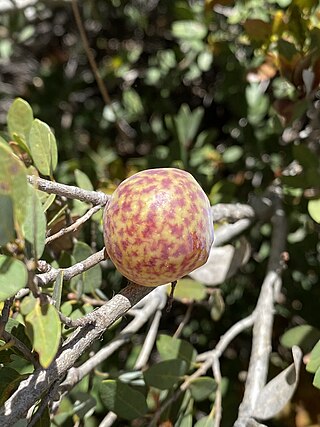
Trichoteras vacciniifoliae, formerly Andricus vacciniifoliae, the golden oak apple wasp, is a species of gall-forming hymenopteran. The wasp creates a stem gall on host plants, namely huckleberry oaks and canyon live oaks. Andricus vacciniifoliae is native to the west coast of North America. Because of their colorful appearance and location on the plant, the galls are often mistaken for fruit. The larval chamber is at the center of the gall, connected to the husk by slender, radiating fibers.

Callirhytis serricornis, formerly Andricus serricornis, the kernel flower gall wasp, is a species of hymenopteran that produces galls on oak trees in California in North America. The wasp oviposits on coast live oak and interior live oak and induces a gall shaped roughly like a bottle or vase. The gall is brown in the first generation, and red and green in the second.

Dryocosmus dubiosus is an abundant species of cynipid wasp that produces galls on oak trees in California in North America. Commonly known as the two-horned gall wasp, the wasp oviposits on the leaves and catkins of coast live oaks and interior live oaks. After the eggs hatch, the resulting gall form looks like it has a set of bull's horns.

Xanthoteras teres, the ball-tipped gall wasp, is a species of cynipid wasp that produces galls on oak trees in Oregon and California in North America. The wasp oviposits on the leaves of Oregon oaks and leather oaks, resulting in a somewhat Suessian gall that has an upright stalk topped by a fuzzy ball. The species was first described by Lewis Hart Weld in 1926.

Dryocosmus minusculus is an abundant species of cynipid wasp that produces galls on oak trees in California in North America. Commonly known as the pumpkin gall wasp, the wasp oviposits on the leaves of black oak group.

Callirhytis perfoveata, formerly Andricus perfoveata, the leaf ball gall wasp, is a species of hymenopteran that produces leaf galls on oak trees in California in North America. The wasp oviposits on coast live oak, interior live oak, and occasionally on California black oak, and induces what appears to be a roughly spherical gall embedded within the leaf. The gall is initially bright green and turns brown as it ages.

Cystotheca lanestris, also Sphaerotheca lanestris, the live oak witches' broom fungus, is a species of mildew that induces stem galls called witch's brooms on oak trees in California in North America. This fungus infects coast live oaks, interior live oaks, canyon live oaks, valley oaks, and tanoaks, and is most commonly found along the coast.
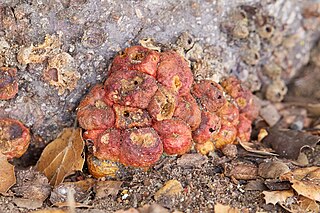
Callirhytis apicalis, formerly Andricus apicalis, the trunk gall wasp, is a species of hymenopteran that induces galls on the trunks or roots of black oak group trees in California in North America. Newly formed galls are red or yellow, turning brown as they age. This wasp is most often associated with Quercus agrifolia. This wasp is generally considered uncommon.

Callirhytis carmelensis, formerly Andricus carmelensis, the mottled acorn gall wasp, is a species of hymenopteran that induces galls on the acorns of coast live oaks and interior live oaks in California in North America. The purple or spotted green gall forms where the acorn attaches to the tree and often prevents normal development of the nut. The gall also produces a honeydew secretion that is attractive to other insects. This wasp is generally considered uncommon.

Callirhytis eldoradensis, formerly Andricus eldoradensis, the acorn gall wasp, is a species of hymenopteran that induces galls on the acorns of coast live oaks, interior live oaks, and canyon live oaks in California in North America. This gall is not as readily visible as some of the showier oak galls, but exit holes may be visible on the acorns, and galled acorns are likely to stay on the tree after other acorns have dropped. The unisexual generation of this wasp produces a modest bud gall.
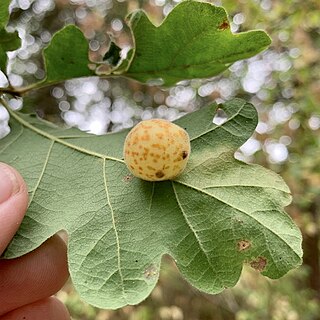
Besbicus mirabilis, formerly Cynips mirabilis, also known as the speckled gall wasp, is a common species of cynipid wasp that produces galls on oak trees in North America. This wasp oviposits on the midrib of the underside of Oregon oak leaves. One to three detachable galls per leaf have been observed. The larval chamber is at the center of the gall, connected to the husk by slender, radiating fibers. The second generation of this wasp induces bud galls. The galls may be parasitized by moth larva or eaten by earwigs or other enterprising arthropods before the larva complete their development. This wasp is present on the Pacific coast of North America from British Columbia to northern California.
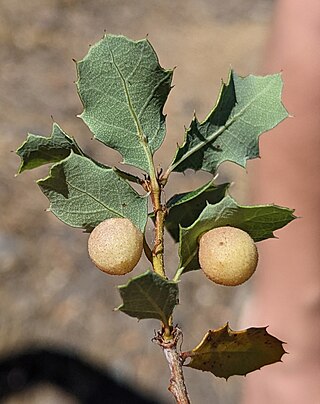
Besbicus maculosus, formerly Andricus maculosus and Cynips maculosa, also known as the pear gall wasp, is an uncommon species of cynipid wasp that induces galls on oak trees on the west coast of North America. The wasp oviposits on leather oak and scrub oak leaves. Fresh galls are green. This wasp has been observed in California.
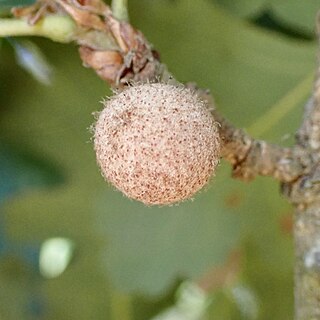
Burnettweldia washingtonensis, formerly Disholcaspis washingtonensis, the fuzzy gall wasp, is a species of hymenopteran that induces stem galls on white oaks on the Pacific coast of North America. The detachable galls have a little stem or neck, are gray or beige and fuzzy, and measure about 8–10 mm in diameter. The larval chamber is located at the center of the ball, the interior of which is otherwise chocolate brown. Older galls may appear pitted. The locally common galls induced by this wasp are sometimes mistaken for the galls induced by Besbicus conspicuus.
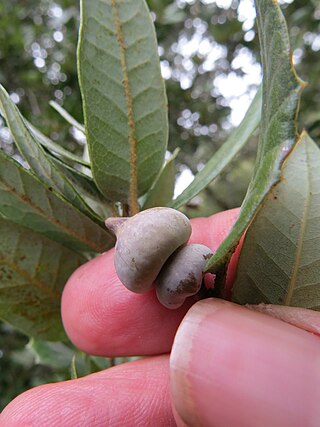
Heteroecus sanctaeclarae, also known as the mushroom gall wasp, is a species of cynipid wasp that induces galls on huckleberry oaks and canyon live oaks on the Pacific coast of North America.
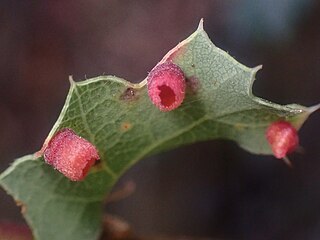
Phylloteras cupella, formerly Trigonaspis cupella, also known as the urn gall wasp or the banded urn gall wasp, is a species of cynipid wasp that induces leaf galls on a number of oak species in western North America. Host species include Arizona white, blue, Engelmann, gray, leather, netleaf, scrub, and shrub oaks. In the United States, galls induced by this species of wasp have been documented in California, Arizona, and New Mexico. This wasp is most likely also in Mexico and Canada.




















